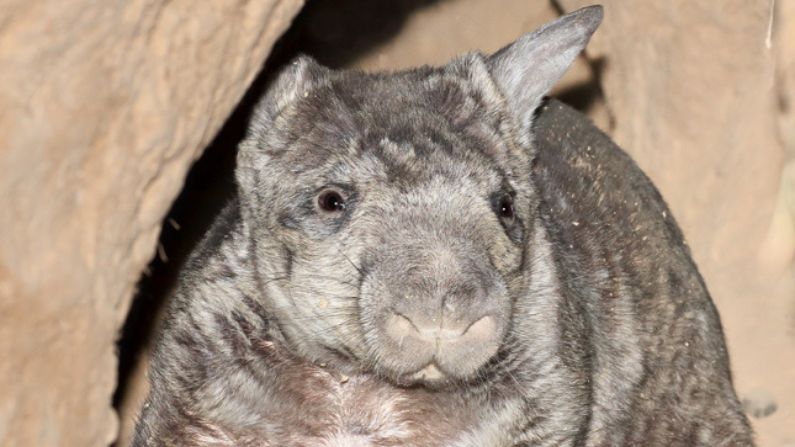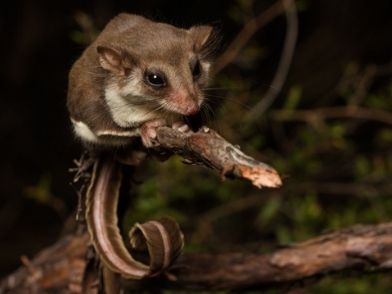Northern
hairy-nosed wombat
© Graham Lee
The northern hairy-nosed wombat, Queensland’s most endangered mammal, has reached a population milestone, now exceeding more than 300. When the species was first surveyed, in the early 1980s, there were just 35 wombats, found in only one location in the world — here, in Queensland. Since then, the Queensland Government, with the support of many organisations, landowners, and volunteers, has undertaken recovery actions to bring the species back from the brink.
Quick facts
COMMON NAME:
Northern hairy-nosed wombat
SCIENTIFIC NAME:
Lasiorhinus krefftii
FAMILY:
Vombatidae
RECOVERY PLAN
Recovery plan for the northern hairy-nosed wombat (Lasiorhinus krefftii) 2004-2008
ALSO KNOWN AS:
Yaminon (Indigenous name from the region of St George, south-western Queensland)
QLD CONSERVATION STATUS:
Critically Endangered
NATIONAL CONSERVATION STATUS:
Critically Endangered
Did you know?
The northern hairy-nosed wombat is the largest burrowing marsupial in the world.

Threats to the northern hairy-nosed wombat
- Low numbers: the small total population makes the wombat vulnerable to any threat.
- Drought: during recent drought episodes the wombats remained robust but stopped breeding.
- Bushfire: the wombats stay safe in their burrows but the fire destroys the native grasses that are their main food.
- Competition for food: main competitor is the eastern grey kangaroo.
- Predation: at least 10 wombats were killed by dingoes in 2000 and 2001 at Epping Forest National Park. A 20km predator-proof fence was erected after this event.
- Disease: such as toxoplasmosis (found in cat faeces) or mange are potential threats to the wombats.
- Loss of habitat: through tree clearing and habitat alteration means that there are a limited number of places in which to establish new populations of northern hairy-nosed wombats.
Distribution
Only found in Epping Forest National Park in central Queensland and the Richard Underwood Nature Refuge in southern Queensland.
- Epping Forest National Park: 3160 hectares of open eucalypt woodland and brigalow communities. Gazetted in 1971.
- Richard Underwood Nature Refuge: approximately 130 hectares of eucalypt woodland on old river levees. Gazetted in November 2008.
History
Although once widespread in New South Wales, Victoria and Queensland, this wombat only lives in alluvial sand habitats, so the northern hairy-nosed wombat was probably always the least numerous of Australia’s three wombat species. At the time of European settlement, only three populations were recorded: near Deniliquin NSW, Moonie River near St George in Southern Queensland, and the Epping Forest of Central Queensland.
The Deniliquin and Moonie River populations became extinct in the early 1900s due to a combination of introduced grazing animals and drought. The remaining population at Epping Forest declined dramatically for similar reasons.
A second colony of northern hairy-nosed wombats was established in 2009 at Richard Underwood Nature Refuge at Yarran Downs near St George in southern Queensland.
Description
- Heavy-set and short-limbed with broad heads and short, strong legs and claws for burrowing.
- Up to 40 kg with an average adult weight of 32 kg.
- More than 1 m long.
- Body covered in soft grey fur including its nose.
- The northern hairy-nosed wombat has longer and more pointed ears and a broader muzzle than the other two species.
Signs
- Huge burrow entrances in sandy country, particularly sand ridges near rivers, often big enough to shelter a wallaby, with two to three runways leading into the entrance.
- Mounds of sand, 1m high and 2m across, outside burrow holes.
- Active burrows marked by dung piles and urine splashes on the mounds, runways and trails leading to the burrow.
Habitat
- Semi-arid zone, deep sandy soils along shallow and vegetated dry creek beds and gullies.
- Major burrows usually close to trees.
Ecology
Life history and behaviour
- Groups of up to 10, equally divided by sex, live in grouped burrows with central permanent homes and temporary refuges around the perimeter of the complex.
- Females share burrows but males live alone.
- Females leave the range after weaning their young.
- Live at least 23 years in the wild.
- Nocturnal. Live underground in burrow networks and avoid venturing above ground in harsh weather extremes because the burrows maintain a constant humidity and comfortable temperature range.
Breeding
- Young are generally born during the wet season in November–April.
- In good rainfall years, 50–80 per cent of females may breed each year and give birth to one baby at a time.
- Young stay in the pouch for 8–9 months and are weaned at about 12 months.
- After leaving the pouch at about 9 months, young stay in the burrow while their mothers go out to forage.
Food
- Northern hairy-nosed wombats do not need to feed every day because they have a low metabolic rate compared to other marsupials.
- Feed for an average of six hours a night in winter and two hours in summer. Their conservative lifestyle and efficient digestive system enable them to make the most of this comparatively short feeding time (a similar-sized kangaroo feeds for 18 hours a day).
- Main food is native grasses (black speargrass, bottle washer grasses, golden beard grass, and three-awned grass) plus introduced buffelgrass. (Buffel grass has become a threat as it out-competes the native grasses and is fire-prone and hard for the wombat to move around in.)
- The wombats make the most of the nutrition they get from their diet. They eat the leaves of grass rather than stems and grind their food finely. Their teeth grow throughout their lives, so old wombats can eat as efficiently as younger animals.
- Wombat intestines are long and contain large colonies of digestive microorganisms.
More information
Publications & websites
- How is the habitat managed at Epping Forest National Park?
- Managing the Richard Underwood Nature Refuge for the wombats
- Horsup A.B., and Johnson, C.N. (2008). Northern hairy-nosed wombat, Lasiorhinus krefftii. In Van Dyck. S. and Strahan, R. (ed.s), The Mammals of Australia. Reed New Holland.




